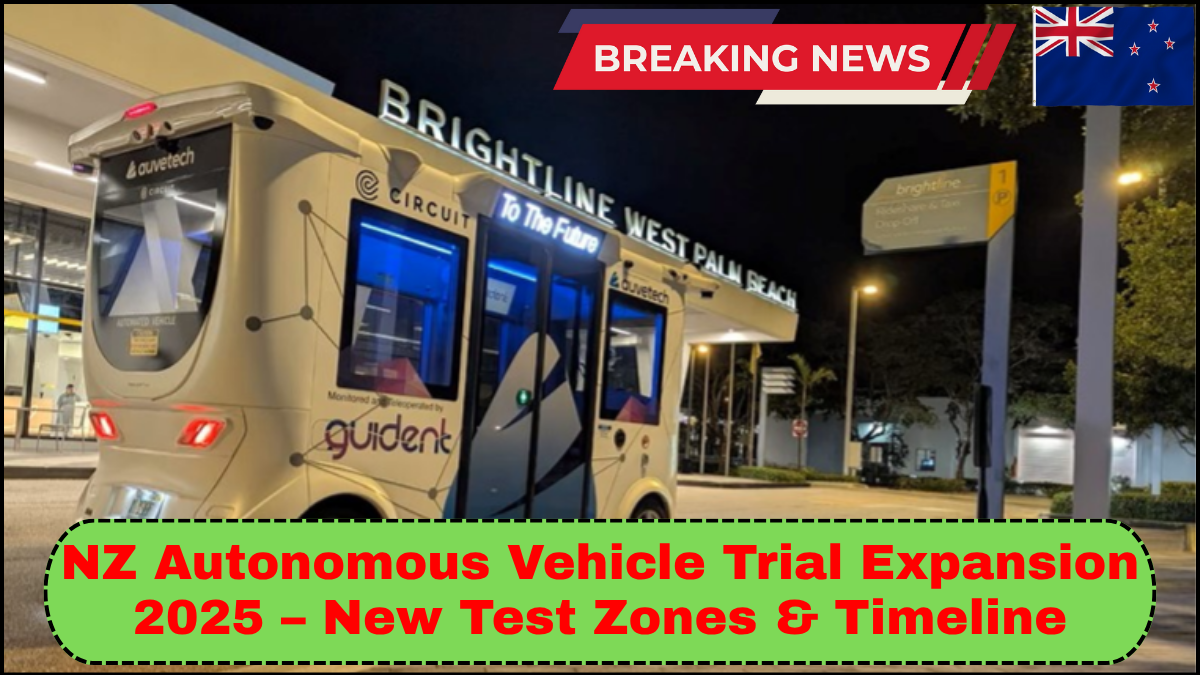New Zealand is fast-tracking its journey into the future of mobility with the NZ Autonomous Vehicle Trial Expansion 2025. This initiative marks a bold step forward in the country’s strategy to integrate cutting-edge transportation technologies into its infrastructure. With new test zones, a clearly defined timeline, and updated regulatory support, the expansion signals New Zealand’s commitment to becoming a global hub for self-driving cars and autonomous vehicle testing.

H3: Overview of the 2025 Expansion
The 2025 expansion follows a successful series of pilot trials conducted in select urban areas over the past five years. This new phase significantly broadens the geographic and technological scope of the program. The Ministry of Transport, in collaboration with NZTA (Waka Kotahi), has approved the launch of autonomous vehicle road trials in five newly designated zones, ranging from high-density urban corridors to semi-rural routes.
The overarching goal? To test how autonomous vehicles perform in varied driving conditions, including peak traffic, suburban settings, and less predictable rural roads. It’s a move that aligns with international trends, as countries worldwide race to integrate self-driving technology with mainstream transportation systems.
H3: Newly Announced Test Zones
In the 2025 expansion, five key areas have been identified as new autonomous vehicle test zones:
-
Christchurch Innovation Precinct – Known for its tech-forward ecosystem, this area will focus on last-mile delivery AVs and micro-transit systems.
-
Hamilton City Fringe – A mix of residential and light industrial roads will be used to evaluate vehicle decision-making in complex, mixed-use environments.
-
North Shore, Auckland – This bustling suburban area will test AVs during school hours, shopping traffic, and rush hour scenarios.
-
Wellington Southern Corridor – Emphasis will be on weather variability, hilly terrain, and integration with public transport.
-
Queenstown Tourist Routes – With heavy seasonal tourist traffic, this zone aims to study AV navigation under fluctuating pedestrian density and unfamiliar driver behavior.
Each zone has been selected for its unique characteristics, pushing AV systems to adapt to different terrains, traffic behaviors, and infrastructure layouts.
H3: Key Technologies Being Tested
The expanded trial isn’t just about where AVs can drive—it’s about how well they can drive. The following technologies are under the microscope:
-
Real-time data processing via edge computing
-
V2X (Vehicle-to-Everything) communication for real-time alerts and interaction with smart infrastructure
-
Sensor fusion to combine data from lidar, radar, and cameras for better decision-making
-
Dynamic geofencing for real-time restriction updates, ideal for emergencies or construction zones
Several NZ-based startups, along with international automotive giants, are participating in these trials, contributing both hardware and software solutions tailored for New Zealand’s road conditions.
H3: Timeline and Regulatory Roadmap
The NZ Autonomous Vehicle Trial Expansion 2025 follows a strict rollout timeline:
-
Q1 2025: Infrastructure mapping and sensor calibration in new zones
-
Q2 2025: Low-speed testing of delivery and shuttle AVs
-
Q3 2025: Full-route autonomous vehicle testing under supervision
-
Q4 2025: Public interaction trials and integration with local transport systems
The Ministry of Transport is also reviewing regulatory frameworks to support safe testing. This includes temporary exemptions, insurance policy revisions, and strict data reporting requirements. Transparency and public safety remain top priorities, with all trial participants required to report near misses, malfunctions, and compliance metrics in real-time.
H3: Economic and Social Impacts
This trial expansion is more than a tech demonstration—it’s a blueprint for the future of NZ transport. The potential benefits include:
-
Reduced congestion through optimized routing algorithms
-
Lower emissions, especially when AVs are paired with electric drivetrains
-
Improved road safety by eliminating human error, responsible for over 90% of accidents
-
Job creation in sectors like AI, robotics, infrastructure, and regulatory services
There are also important conversations happening around job displacement, ethical programming, and data privacy. The government has committed to stakeholder consultations to ensure that AV integration is inclusive and socially responsible.
FAQs
Q1: What is the main objective of the NZ Autonomous Vehicle Trial Expansion 2025?
The main goal is to test self-driving vehicle technology in diverse real-world conditions across new test zones, advancing safety, efficiency, and readiness for commercial use.
Q2: Who is managing the trial expansion?
The program is jointly overseen by the New Zealand Ministry of Transport and Waka Kotahi (NZ Transport Agency), with contributions from industry partners and academic institutions.
Q3: Can the public interact with these autonomous vehicles?
Yes. From Q3 2025 onward, trials will include supervised public interaction in select zones, such as AV shuttles and delivery bots.
Q4: Are there any safety concerns?
Safety is a top priority. All trials follow strict guidelines for vehicle behavior, emergency protocols, and reporting. Each AV must be monitored either remotely or by an onboard safety driver.
Q5: Will this lead to fully autonomous public transport?
That is the long-term vision. These trials will inform future rollouts of autonomous buses, taxis, and shared mobility solutions.
click here to learn more